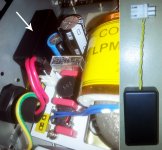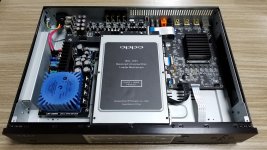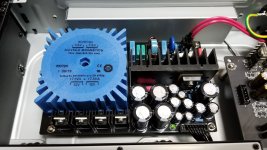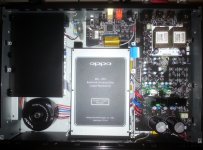So the first is a bog standard 'Virtual Earth' I/V converter.
The second shows the added components, five per channel: Two resistors, two small chokes/inductors and a single capacitor.
I would recommend trimming the 0.18uF (or 180nF) down in value and aim for the flattest response at 20KHz. You might find that with 0.18uF it will be down a negligible 0.25dB, hardly a bad result, but some like 0.17uF or 170nF combination of parallel caps, will tweak the circuit.
But just try it with 0.18uF to get you started and if you like what it does, then tweak it.
The 47uH coils, we used some that was rated at 3A, so saturation is not going to be a problem.

We also unwrapped the wire and much less than a metre, we remade them with better wire, so that can also be a later tweak, but the coils did work standard quite well.
OK, up to you to try it. Cheers, Joe.
.
Further to my previous post, using passive is a good way to go, especially
if you have low DAC -> IV impedances, the inductors can be relatively small.
I have made many of these both 2nd and 3rd order.
The crucial part is the inductor, specifically core material. You will find that
the 47uH spec can actually be only over a limited BW and that can be quite a
bit higher than 20kHz. Remember that these inductors are mainly used for
mains RF filtering applications.
Obviously the best inductor is an air core one but then the DCR will go up
as you need more turns. It will also most likely need shielding.
This brings back memories. I've got boxes of inductors / coils / transformers
etc that were used for I-V applications.
T
LPS board for OPPO UDP-203
I just finished developing the LPS board for UDP-203.
It is working nicely , perfectly replaced the orig swtching ps.
I use a Nuvotem 35VA onboard trans, opamp + mos reg circuit.
This LPS is suppling a DC12V to the main board only. No power to the DAC board, which I will never use.
I just finished developing the LPS board for UDP-203.
It is working nicely , perfectly replaced the orig swtching ps.
I use a Nuvotem 35VA onboard trans, opamp + mos reg circuit.
This LPS is suppling a DC12V to the main board only. No power to the DAC board, which I will never use.
Attachments
Nice design.
I would like to point out that in case of not using (powering) the DAC board (203), the flat cable in between main board and audio board it should be disconnected, preventing so possible randomly functional issues (sections of audio board partially powered through the flat cable).
I would like to point out that in case of not using (powering) the DAC board (203), the flat cable in between main board and audio board it should be disconnected, preventing so possible randomly functional issues (sections of audio board partially powered through the flat cable).
I just finished developing the LPS board for UDP-203.
It is working nicely , perfectly replaced the orig swtching ps.
I use a Nuvotem 35VA onboard trans, opamp + mos reg circuit.
This LPS is suppling a DC12V to the main board only. No power to the DAC board, which I will never use.
Looks neat. I have a question, how much more heat does it produce and also, can you feel the case being warmer?
This brings back memories. I've got boxes of inductors / coils / transformers
etc that were used for I-V applications.
T
Hi Terry
Sorry, I was overseas and didn't spot your post, but right on.
Chokes are making a comeback, like also in RIAA EQ.
Cheers, Joe
Looks neat. I have a question, how much more heat does it produce and also, can you feel the case being warmer?
Yes, it produced more heat than the orig PS. touching the heatsink, I think it is about 50"c. The case is warm if I enclose the conver and play few hours.
Hello,
I have got two questions:
1.)
I do own an OPPO 203.
I consinder changing the originally built in power supply against a good linear ps, for example the "clones audio PSUPD".
Would that be a step forward in overall quality (sound? picture?).
Are there alternative power supplies you might suggest?
As I am no technician, I need a "plug & play" power supply, where I just will have to exchange the complete pcb.
At present I use the 203 via HDMI-out in combination with a NAD M51 DAC.
2.)
How good is the "bigger" 205 concerning sound quality as a standalone CD/SACD-player compared to the top-high-end-players from Accuphase, McIntosh, Luxman or the great YAMAHA CD-S3000?
Greetings from Bavaria,
Alexander
I have got two questions:
1.)
I do own an OPPO 203.
I consinder changing the originally built in power supply against a good linear ps, for example the "clones audio PSUPD".
Would that be a step forward in overall quality (sound? picture?).
Are there alternative power supplies you might suggest?
As I am no technician, I need a "plug & play" power supply, where I just will have to exchange the complete pcb.
At present I use the 203 via HDMI-out in combination with a NAD M51 DAC.
2.)
How good is the "bigger" 205 concerning sound quality as a standalone CD/SACD-player compared to the top-high-end-players from Accuphase, McIntosh, Luxman or the great YAMAHA CD-S3000?
Greetings from Bavaria,
Alexander
Waveform measurement results for the newly developed Femto clock.
The upper part shows the original waveform as it is. It shows the appearance of sine wave and you can see that the jitter is very high. (The bar graph shows the distribution and size of the jitter)
On the other hand, after mounting the Femto clock, it shows a perfect waveform with almost exact square appearance and little jitter.
This femto clock has a frequency accuracy of about 0.1 PPM, but the waveform looks very accurate.
On the other hand, OCXO (Oven ctrystal clcok) waveforms are not as good as Femto clock, but they have excellent frequency accuracy of 0.001 PPM.
In other words, OCXO is to pursue frequency accuracy while Femto clock that pursues the accuracy of waveform in clock.
I compared the these two approches in respect of picture quality and sound quality. It is difficult to judge the difference in picture quality at this point of the femto clock of about 10 days burn in tiimes.
My video system consits with 110-inch Stewart Cima screen and a 3- DLP projector, the RUNCO LS-12D.
Both are wonderful. However, on the audio side, the Femto clock seems seems ti be better. It is felt especially in the bass .

(original clock )

( Femto clock )

( femto clock board)
Each clock buffers are installed to the spot of original clock to eliminate the effect of wiring form Femto clock ( hiden in PCBs )
Jae H. Lee Blog :: Jae H. Lee Blog
The upper part shows the original waveform as it is. It shows the appearance of sine wave and you can see that the jitter is very high. (The bar graph shows the distribution and size of the jitter)
On the other hand, after mounting the Femto clock, it shows a perfect waveform with almost exact square appearance and little jitter.
This femto clock has a frequency accuracy of about 0.1 PPM, but the waveform looks very accurate.
On the other hand, OCXO (Oven ctrystal clcok) waveforms are not as good as Femto clock, but they have excellent frequency accuracy of 0.001 PPM.
In other words, OCXO is to pursue frequency accuracy while Femto clock that pursues the accuracy of waveform in clock.
I compared the these two approches in respect of picture quality and sound quality. It is difficult to judge the difference in picture quality at this point of the femto clock of about 10 days burn in tiimes.
My video system consits with 110-inch Stewart Cima screen and a 3- DLP projector, the RUNCO LS-12D.
Both are wonderful. However, on the audio side, the Femto clock seems seems ti be better. It is felt especially in the bass .

(original clock )

( Femto clock )

( femto clock board)
Each clock buffers are installed to the spot of original clock to eliminate the effect of wiring form Femto clock ( hiden in PCBs )
Jae H. Lee Blog :: Jae H. Lee Blog
Last edited:
I have ordered a '203 - but may not get it for a month - the Australian importer is out of stock.
I want to sort the clocking on the '203 motherboard before moving on to '205 later. I wish they had stayed with the same single 27MHz master clock they did with the '105.
Once I have sorted the clocking out, then on the '203 I am going to use a 1:1 transformer for the AK4458 DAC's output. I will use a Zobel on the output, it will make the output just fractional low at 20KHz and -1.5dB down at 20KHz. This is my infamous Voldemort Filter that has no name, hence it shall be known as Voldemort from this time onward.
Some power supply noise reduction techniques in and around the AKM DAC. I won't we changing the SMPS - the noise cannot get into the 1:1 transformers as they can when you are using audio ICs with feedback. I have already done this to an Oppo BDT-101 that was fitted with AK4490 DAC and transformer plus Voldemort sounded just great.
Any comments welcome.
I want to sort the clocking on the '203 motherboard before moving on to '205 later. I wish they had stayed with the same single 27MHz master clock they did with the '105.
Once I have sorted the clocking out, then on the '203 I am going to use a 1:1 transformer for the AK4458 DAC's output. I will use a Zobel on the output, it will make the output just fractional low at 20KHz and -1.5dB down at 20KHz. This is my infamous Voldemort Filter that has no name, hence it shall be known as Voldemort from this time onward.
Some power supply noise reduction techniques in and around the AKM DAC. I won't we changing the SMPS - the noise cannot get into the 1:1 transformers as they can when you are using audio ICs with feedback. I have already done this to an Oppo BDT-101 that was fitted with AK4490 DAC and transformer plus Voldemort sounded just great.
Any comments welcome.
I have a 103 and am very happy with it, but with the 203 and 205 now it’s very tempting to get one of the new units, only using it for audio so????
In some ways, as an upgrade, I think what I just explained in that post re '203 might be a real sweet spot for an upgrade. Ther '203 is a lot less cost-effective, but now has a really good 32bit DAC. But that idea of using 1:1 transformers is not so good with the Sabre DACs used in the bigger models of Oppo (the impedance of the DAC outs are not super low), but AKM DACs are ideal for this. Transformers 1:1 should be used more often, the output is near 2V RMS and no sacrifice there compared to before, maybe only 1dB less output.
The processor clock in 203 (and 205) it still be the same as before, 27Mhz. The optical drive processor clock is 25Mhz.
I think is a good idea using transformers. I thought at the same approach of using it to output from AKM DAC in 203. Not implemented yet as I intended to use Lundahls, and these are quite big for the available place inside (after modifications). I have also obtained very good results with my own post DAC analogue balanced stage (opamps). I already mounted Lundahl transformers in 205, and it is well working so far. I am still working in this field...
I may only say that using a linear power supply for digital stage is just a must and primary step to be done, improving everything dramatically. The original SMPS it will not affect the DAC output transformer in itself, but it inject lot of large spectre noises in the whole system. This is the main issue of the SMPS. I realised my LPM so to dissipate minimum heat (barely noticeable).
I think is a good idea using transformers. I thought at the same approach of using it to output from AKM DAC in 203. Not implemented yet as I intended to use Lundahls, and these are quite big for the available place inside (after modifications). I have also obtained very good results with my own post DAC analogue balanced stage (opamps). I already mounted Lundahl transformers in 205, and it is well working so far. I am still working in this field...
I may only say that using a linear power supply for digital stage is just a must and primary step to be done, improving everything dramatically. The original SMPS it will not affect the DAC output transformer in itself, but it inject lot of large spectre noises in the whole system. This is the main issue of the SMPS. I realised my LPM so to dissipate minimum heat (barely noticeable).
Last edited:
Thank you both for your informative words. I've been reading both of your threads in this blog and I have to say i'm not that technically savy on the digital side of cd players . So thanks for taking the time to stop and answer my simple questions. I 'm probably savy enough to replace power supply's and such so ill keep reading your word , thanks so much
my 205...
Here is my (finished???) 205. Well, I can say that all the improvements are now in place, even thought some improvements it can be even more... improved.
I could chose very well the original post DAC analogue processing (improved of course), because the original opamps are very good quality components. However, I chosen to experiment with Lundahl transformers, and for moment I will let it so. Next step is to use another type Lundahls.
The DAC two available output channels are tied together. I use balanced output, but the existent transformers it allow simultaneous unbalanced outputs as well. DAC chip clocked by a 108Mhz SAW oscillator.
Very surprisingly for me, using the improved device, I noticed as the best by far quality signal, through USB in. Then I powered the digital input stage from linear power (from LPM dedicated section). A even more surprise: a really new sound. Astonishing details, dynamics, sound scene and resolution.
Quite nice so far....
Here is my (finished???) 205. Well, I can say that all the improvements are now in place, even thought some improvements it can be even more... improved.
I could chose very well the original post DAC analogue processing (improved of course), because the original opamps are very good quality components. However, I chosen to experiment with Lundahl transformers, and for moment I will let it so. Next step is to use another type Lundahls.
The DAC two available output channels are tied together. I use balanced output, but the existent transformers it allow simultaneous unbalanced outputs as well. DAC chip clocked by a 108Mhz SAW oscillator.
Very surprisingly for me, using the improved device, I noticed as the best by far quality signal, through USB in. Then I powered the digital input stage from linear power (from LPM dedicated section). A even more surprise: a really new sound. Astonishing details, dynamics, sound scene and resolution.
Quite nice so far....
Attachments
Last edited:
- Home
- Source & Line
- Digital Source
- Oppo new UDP series players - 203/205 - Discussions, upgrades, modifications



